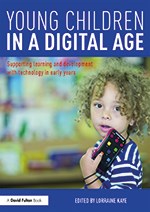Learning & Development: ICT - New age
Lorraine Kaye
Monday, September 5, 2016
In an extract from her new book Young Children in a Digital Age, Lorraine Kaye explains why technology should be incorporated into early years settings to support play and learning

Since the establishment of the first nursery school there have been a vast number of developments in early childhood education. However, current developments seem to have neglected to take account of the advances in technology and the digital society in which young children live.
The separation of play and technologies in early childhood curriculum documents persists despite rapid advances in the pace of digitisation in post-industrial societies (Hobbs, 2010) and the consequent need for young children to develop ‘new’ skills in reading, navigating and participating in highly digitally mediated environments (Bittman et al, 2011).
This situation suggests that new ways of thinking about play and technology are needed to address the gap between pedagogical perspectives on play and the use of technologies in early childhood education so we are better equipped to support children's learning in a digital age.
INCORPORATING TECHNOLOGY IN AN EY CURRICULUM
Key issues and challenges
- Current research has identified multiple benefits of the use of technology by young children. These include:
- facilitating cognitive development
- enhancing creative thinking and problem-solving skills
- improving social interaction and language.
It is not suggested that the use of technology should replace current, valued practice involving activities using blocks, sand, water, art, dramatic play, outdoor play, books, emergent writing activities, etc. Rather, the technological tools supplement the children's learning and development. The challenge then for many early years settings is the integration of technological tools into their curriculum and planning in order to maximise the benefits.
A further challenge is the ongoing debate over the place of technology in children's lives, which may lead to some confusion and questioning of practitioners’ beliefs in the use of technology in early years education: ‘[The] mismatch in advice from research and major organisations may lead to more insecurity over using technology with young children, which then could impact teachers’ actual use’ (Blackwell et al, 2013).
In order to support early years educators, a technology policy is needed that sets out how to incorporate technology appropriately into their curriculum to meet the developmental needs of young children.
Key principles
The use of multimedia tools is entirely compatible with the open-ended, non-linear, constructivist model of learning. The technologies allow teachers and children to create interactive lessons, presentations and projects through the integration of images, graphics, text, animation, audio and motion video. Learning is enhanced by communication, resulting in new knowledge, re-organised knowledge or additional understanding, with groups of children learning how to use the tools of their culture in a collaborative learning environment (Cox and Cox, 2009).
The following principles arose from the Kidsmart project (Siraj-Blatchford et al, 2001) and are still relevant in relation to the appropriate use of technology in early years education:
1 Ensure an educational purpose – can the technology be planned into areas of learning?
2 Encourage collaboration – think about your computer set-up; for example, two chairs, with tablets on a table: does the application encourage social play?
3 Integrate with other aspects of the curriculum – as a tool for learning.
4 Ensure the child is in control – can the child control the technology or is it the other way around?
5 Choose applications that are transparent – how user friendly is it? What does someone need to know in order to get the best from it? Can this be broken down easily?
6 Avoid applications containing violence or stereotyping.
7 Be aware of health and safety issues – small mouse, monitors at right angle and height, large buttons on camera, etc.
Parental involvement should also go hand-in-hand with these (Siraj-Blatchford et al, 2001).
Early years educators should be aware of the stages of development towards using a piece of equipment, software or website in order to provide support and to extend children's learning and development. These are based on Piaget's stages of cognitive development (Piaget, 1971):
Stimulated by Should be enjoyable and stimulating; what happens and how.
Explore Provide lots of opportunities to explore in order to gain the relevant knowledge and skills and gain a sense of control.
Practice Provide opportunities to put into practice what they know. Observe and talk through this practice with children and scaffold their learning.
Use for an intended purpose Children begin to use the software for an intended purpose; model different uses of the software.
In fact, many of us go through similar stages ourselves when faced with a new program or technological tool.
IMPLEMENTATION
McManis and Gunnewig (2012) suggest that new digital tools, such as smart mobile devices and their accompanying applications, can offer unique opportunities for young children to participate in useful and targeted activities. Using embedded cameras in such tools to take photographs or video of the world around them, young children are able to create texts and narrative structures connected to their own interests and their own lives and that present purposeful uses of literacy aimed at real audiences. They provide opportunities for children to create, modify and use their own multimodal texts in multiple ways, and to share in collective endeavours (Laidlaw and O’Mara, 2011).
If, for example, children are learning about their environment, they may explore the outdoor area, local park, shops, etc. The use of a tablet or a digital camera by the children may help recall their trip and support discussion and related activities back in the classroom. This may include a sequence of the trip and/or taking photographs of items found in the environment. It is important, therefore, that before the trip, the children know exactly how to operate the digital device they will be using, including how to take pictures and how to delete them. Without these skills the time will be spent on supporting children to use the camera rather than on exploring and observing the environment they are in.
Video-conferencing resources can also help provide authentic experiences to assist young children researching answers to enquiry questions. If children are especially interested in dinosaurs, for example, practitioners can support children in connecting to experts at the Natural History Museum (www.nhm.ac.uk). Video-conferencing applications also provide the opportunity to communicate with children around the world to share experiences and develop their understanding of other cultures.
Early years settings with an interactive whiteboard allow children to explain and extend their thinking across all areas of learning and development through the use of resources which include open-ended questions and discussion opportunities for shared thinking. The interactive whiteboard can enhance children's learning by ‘allowing children to engage positively in imaginative, active and social learning’ and by ‘offering a visual means for demonstrating and exemplifying… [involving] children in watching, listening, doing, constructing and creating’ (Price, online).
Additionally, embedding technology in an early years curriculum can provide a vital connection to family members and the wider community. The maintenance of a blog or website provides the opportunity for children to share learning and experiences with friends and family – at home and abroad. It can also provide important information for parents, carers and the community about events, etc.
There are numerous examples of early years centres which have successfully embedded technology throughout their curriculum, such as Hampden Way Nursery (www.hampdenway.barnet.sch.uk) and Gamesley Early Excellence Centre (www.gamesleyeec.org.uk), whose websites provide examples and suggestions.
The most significant factor found in the integration of technology in these centres was the belief, understanding and commitment by practitioners of the potential benefits and relevance of technology to support, enhance and extend children's learning and development in a digital age.
This is an edited extract from ‘State of play – technology in the early years curriculum’ in Young Children in a Digital Age: Supporting learning and development with technology in early years, edited by Lorraine Kaye (Routledge, £19.99).
YOUNG CHILDREN IN A DIGITAL AGE
 Young Children in a Digital Age: Supporting learning and development with technology in early years, edited by Lorraine Kaye (Routledge, paperback, £19.99), is a timely new textbook. It examines how advances in technology, particularly mobile and touchscreen technology, have impacted children's lives and how, when used appropriately, this can support all aspects of a child's development.
Young Children in a Digital Age: Supporting learning and development with technology in early years, edited by Lorraine Kaye (Routledge, paperback, £19.99), is a timely new textbook. It examines how advances in technology, particularly mobile and touchscreen technology, have impacted children's lives and how, when used appropriately, this can support all aspects of a child's development.
Clearly linking theory and research to everyday practice, the book offers guidance on:
- the role of technology in the early years curriculum
- the role of the adult within digital play activities
- how to use technology to enhance and develop young children's creativity and language development.
To order the book and qualify for a 20 per cent discount*, order at www.routledge.com/9781138804807 using code NWO16.
*Discount is valid until 31/12/16. It applies to print books and cannot be used in conjunction with any other offer or discount.




